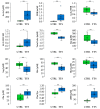Unraveling Pathophysiology of Takotsubo Syndrome: The Emerging Role of the Oxidative Stress's Systemic Status
- PMID: 36556129
- PMCID: PMC9781109
- DOI: 10.3390/jcm11247515
Unraveling Pathophysiology of Takotsubo Syndrome: The Emerging Role of the Oxidative Stress's Systemic Status
Abstract
Takotsubo Syndrome (TTS) is usually triggered by emotional or physical stressors, thus suggesting that an increased sympathetic activity, leading to myocardial perfusion abnormalities and ventricular dysfunction, plays a major pathogenetic role. However, it remains to be elucidated why severe emotional and physical stress might trigger TTS in certain individuals but not others. Clinical research has been focused mainly on mechanisms underlying the activation of the sympathetic nervous system and the occurrence of myocardial ischemia in TTS. However, scientific evidence shows that additional factors might play a pathophysiologic role in the condition's occurrence. In this regard, a significant contribution arrived from metabolomics studies that followed the systemic response to TTS. Specifically, preliminary data clearly show that there is an interplay between inflammation, genetics, and oxidative status which might explain susceptibility to the condition. This review aims to sum up the established pathogenetic factors underlying TTS and to appraise emerging mechanisms, with particular emphasis on oxidative status, which might better explain susceptibility to the condition.
Keywords: Takotsubo syndrome; genetics; inflammation; myocardial ischemia; oxidative stress; personalized treatment.
Conflict of interest statement
The authors declare no conflict of interes.
Figures






References
-
- Pelliccia F., Parodi G., Greco C., Antoniucci D., Brenner R., Bossone E., Cacciotti L., Capucci A., Citro R., Delmas C., et al. Comorbidities frequency in takotsubo syndrome: An international collaborative systematic review including 1109 patients. Am. J. Med. 2015;128:654.e11–654.e19. doi: 10.1016/j.amjmed.2015.01.016. - DOI - PubMed
Publication types
LinkOut - more resources
Full Text Sources

